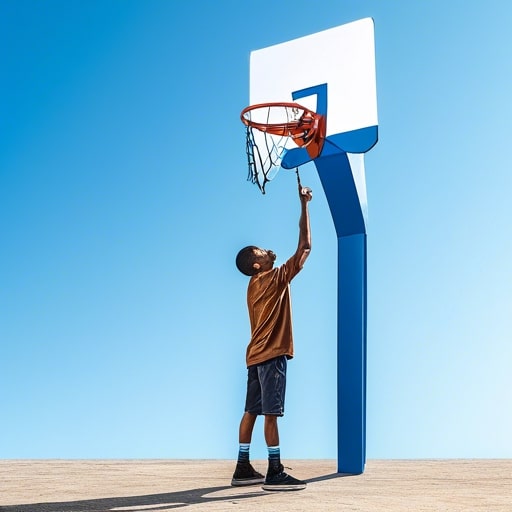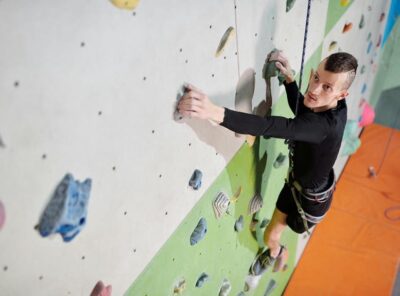Key Factors In Dunk Height Estimation Accuracy
To accurately estimate dunk height, consider key factors like standing reach, arm length, vertical leap, and player height.
Standing reach is approximately 1.33 times your height, directly impacting your dunking potential. Longer arms provide better control and leverage during dunks, affecting performance greatly.
Using tools like vertical height calculator for vertical leap measurements guarantees accuracy, while understanding the 10 feet height requirement for successful dunks is essential.
Taller players often have an advantage due to their height, but training can enhance skills for dunking success regardless of height. Further insights await on how these elements interact to optimize your dunking abilities.
Key Takeaways
- Utilize precise standing reach measurements for accurate dunk height estimation.
- Consider arm length variations to calculate the impact on reaching dunking heights.
- Implement reliable vertical leap measurement techniques for dunking height assessment.
- Factor in player height and vertical jump data to enhance dunk height accuracy.
- Ensure consistent and standardized measurement tools for reliable dunk height estimations.
Standing Reach and Its Importance
Understanding the importance of standing reach is essential for evaluating your dunking potential. Standing reach typically measures around 1.33 times your height, a key metric in determining your ability to dunk.
NBA players exemplify how arm length impacts dunking, underscoring the significance of standing reach in this situation. To successfully dunk, you must reach a minimum height of 10 feet 6 inches, highlighting the critical role of standing reach.
Achieving a dunk necessitates your hand being above the hoop, showcasing the direct correlation between standing reach and dunking potential. By ensuring your fingertips can reach at least 10 feet 6 inches high, you set yourself up for success in achieving your dunking goals.
Arm Length and Dunk Performance
Understanding the importance of arm length in relation to dunk performance provides valuable insights into how you can enhance your ability to reach the basketball hoop effectively.
Longer arms give you an advantage in dunking by increasing your reach, allowing you to control the ball at higher points during the dunk.
With greater arm length, you have better leverage and control over the ball as you push it down through the hoop. This factor greatly influences the ease and effectiveness of your dunks.
Vertical Leap Measurement Techniques
To accurately measure your vertical leap, utilize tools like the Vertec or Jump Mat for precise assessments. Conduct various jump tests such as the squat jump, countermovement jump, or depth jump to evaluate your vertical leap effectively.
Employ video analysis software to measure jump height by analyzing recorded jumps. Take into account factors like arm swing, knee angle, and takeoff speed when measuring your vertical leap accurately.
By combining multiple measurement techniques, you can guarantee thorough and reliable data regarding your vertical leap.
These methods not only provide you with valuable information about your jumping ability but also help track your progress over time.
Experiment with different techniques to find the most suitable approach for your vertical leap measurement needs.
Dunk Height Requirement in Basketball
Reaching a hoop height of 10 feet is a fundamental requirement for successfully dunking in basketball.
To achieve this, players need to make sure their hand is above the hoop, with their fingertips ideally at least 10 feet 6 inches high for a proper dunk.
Here are three key points to think about regarding the dunk height requirement in basketball:
- The height of the basketball hoop sets the standard for dunking success.
- A strong vertical jump is vital for generating the lift needed to reach the required height.
- Players must focus on improving their vertical jump and overall athleticism to meet the dunking criteria in basketball.
Impact of Player Height on Dunking
Pivoting from the previous discussion on Dunk Height Requirement in Basketball, the impact of player height on dunking proficiency becomes evident in the domain of basketball performance.
In the NBA, taller players often possess a natural advantage in dunking ability. Their increased height and longer arms enable them to reach higher, with their fingertips easily surpassing the 10 feet 6 inches threshold required for successful dunks.
Height, standing reach, and vertical jump all play pivotal roles in determining a player’s dunking prowess. However, regardless of height, players can enhance their dunking skills through proper training regimens tailored to improve their vertical jump and overall athleticism.
Understanding the significance of player height in dunking can help individuals maximize their performance on the court.
Training for Dunking Success
For peak success in dunking, focus on training programs that emphasize plyometrics, strength training, and explosive movements. To maximize your jumping high potential and achieve dunking success, consider the following:
- Incorporate plyometrics like box jumps to enhance explosive power.
- Implement strength training exercises such as squats and deadlifts to build lower body strength.
- Focus on proper technique during vertical jump drills to improve form and efficiency.
Factors Affecting Dunk Accuracy
To achieve precise dunk accuracy, understanding the factors that influence height estimation is essential.
Factors like vertical jump capabilities, arm length measurement, wind resistance, and body positioning play important roles in determining the accuracy of dunk height calculations.
In the NBA Slam Dunk Contest, where every inch matters, having accurate arm length and reach measurements is crucial for estimating the height reached during a dunk.
Additionally, considering the player’s vertical jump capabilities provides insight into how high they can jump, contributing to more accurate dunk height assessments.
Factors such as wind resistance and body positioning can affect the trajectory of the jump and ultimately impact the dunk accuracy.
By paying attention to these variables, you can improve the precision of your dunk height estimations.
Combining Skills for Dunking Improvement
Enhancing your dunking skills involves combining strength training with plyometric exercises for improved vertical jump ability. To jump higher and dunk successfully, consider the following:
- Focus on Explosive Power: Incorporate exercises like squats, lunges, and box jumps to build strength and explosiveness in your legs for a higher jump.
- Practice Jumping Technique: Work on your standing vertical jump technique, including proper knee drive and arm swing, to maximize your power when going for the rim.
- Train Like Successful Basketball Players: Emulate the training routines of successful basketball players known for their dunking ability to enhance your own skills and reach new heights on the court.
The Science Behind Dunk Height Calculation
Understanding the mechanics of projectile motion is fundamental to accurately calculating dunk height. When you leap to slam dunk a basketball, you become a projectile under the influence of gravity.
The launch angle at which you jump greatly affects the height you can reach. Wind resistance can slightly alter your trajectory, impacting the time you stay in the air, known as hang time.
Gravity pulls you back down, limiting the time you have to showcase your dunking skills. By mastering these factors and optimizing your launch angle, you can soar to new heights on the court.
Check out the table below for a quick overview of the key components influencing dunk height calculation.
| Factors | Influence on Dunk Height |
|---|---|
| Gravity | Pulls you back down |
| Projectile Motion | Determines your path |
| Launch Angle | Affects maximum height |
| Wind Resistance | Alters trajectory slightly |
| Hang Time | Time spent in the air |
Frequently Asked Questions
At What Height Are You Expected to Dunk?
You are expected to dunk at a height where your hand surpasses the 10-foot basketball hoop. To comfortably accomplish this, your standing reach should be at least 10 feet 6 inches. Achieving a vertical jump higher than the hoop is essential.
What Does Your Vertical Have to Be to Dunk at 6 1?
To dunk at 6’1′, you need a vertical leap of around 29 inches. Achieving this requires dedicated training with exercises like squats and plyometrics. Focus on technique, strength, and explosiveness to reach your dunking goal.
What Percentile of People Can Dunk?
You wanna know who can dunk? Well, only about 1% of folks can throw down that basketball thunder! It’s like reaching for the stars, but with a hoop at 10 feet. Soaring high!
How High Does My Hand Have to Be Above the Rim to Dunk?
To dunk successfully, your hand must clear the rim by at least 6 inches. Achieving a hand height of 10 feet 6 inches is necessary. The gap between your standing reach and the rim height determines your needed jump.
Conclusion
Now that you understand the key factors in dunk height estimation accuracy, you can improve your skills on the court.
By focusing on your standing reach, arm length, vertical leap, and overall training regimen, you can enhance your dunking performance.
Remember, practice makes perfect, so keep working hard and combining your skills to reach new heights in your dunking abilities.
Stay committed, stay focused, and you’ll see progress in no time. Good luck out there!












